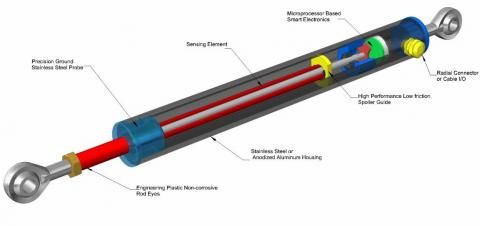Sensing devices for the energy sector

(A cutaway view of an LVIT)
LVITs (Linear Variable Inductive Transducers) have been around for more than 30 years, and are a disruptive technology due to their relatively low cost and flexibility to be packaged in many different forms.
LVITs are contactless position sensing devices that utilize eddy currents developed by an inductor in the surface of a conductive movable element to vary the resonant frequency of an L-C tank circuit.
The most common form of an LVIT uses a small diameter inductive probe surrounded by a conductive tube called a “spoiler” that is mechanically coupled to the moving object. Typical LVITs range from fractions of an inch to 30 or more inches. Modern electronics using microprocessors and small component size is said to help achieve linearity errors of less than ±0.1% and temperature coefficients of 50 ppm/ºF, along with either analog or digital outputs.
LVITs are found in applications that require position information or feedback. Typical LVIT applications include mobile hydraulics, subsea hardware, civil engineering testing, power generation and energy development, and factory automation.
In mobile hydraulics the LVIT is commonly used to measure hydraulic or pneumatic cylinder position. Usually the sensor has a pressure-sealed head and a probe long enough to insert into a gun-drilled hole in the cylinder’s ram. The ID of this hole in the ram then acts as the spoiler.
The sensor head can either be port mounted or embedded into the end cap of the cylinder. This is said to fulfill many applications in mobile hydraulics such as bulldozer shovel or snow plow positioning, boom positioning on hydraulic cranes and manlifts, and in a variety of agricultural vehicle accessory position feedback requirement.
For subsea cylinder applications involving pumps, chokes, blowout preventers, and ROV-based actuators, the LVIT is designed to withstand the internal and/or external pressures of a PBOF (pressure balanced, oil filled) system. Other technologies commonly used to satisfy these applications require additional hardware like a ring magnet to operate, which adds cost to the machining of the cylinder ram and complexity to the installation.
Typical civil engineering applications include measuring bridge expansion and contraction due to seasonal heating and cooling, and related shifts in trunnions and roller support mechanisms.
This problem of expansion and contraction is compounded with railway bridges and trackage, where the expansion of a mile-long section of rail could be as much as 4 feet over a change of temperature in some climates of 100 degrees F. This could lead to rail buckling, known in the industry as “sun kink,” and the derailment of a train. In this type of application, instead of having a bare probe protruding from the sensor head, the LVIT’s probe coil, spoiler, and electronics are packaged inside of a cylindrical housing for heavy duty protection, allowing the sensor to be exposed to its environment. The LVITs are connected to the pier and deck of the bridge to measure the relative position of the two, or directly to the rails to measure rail buckling.
LVIT technology can withstand seasonal weather conditions such as heat, cold, rain, and snow. LVITs are used in many factory automation applications, including packaging and material handling equipment, die platen position in plastic molding machines, roller position and web tension controls in paper mills or converting facilities, and robotic spray painting systems. Being contactless, the basic measurement mechanism of an LVIT does not wear out over time. LVITs also do not have the higher installed cost associated with other contactless technologies.
LVITs are being utilized in specific areas of the energy sector. In power generation applications, LVITs are used for valve position feedback, feedwater pump displacement, or generator shell movement. In oil fields, LVITs are used in hydraulic-operated pumps that replace Lufkin-style
pump jacks, and to measure the poppet position inside check valves.